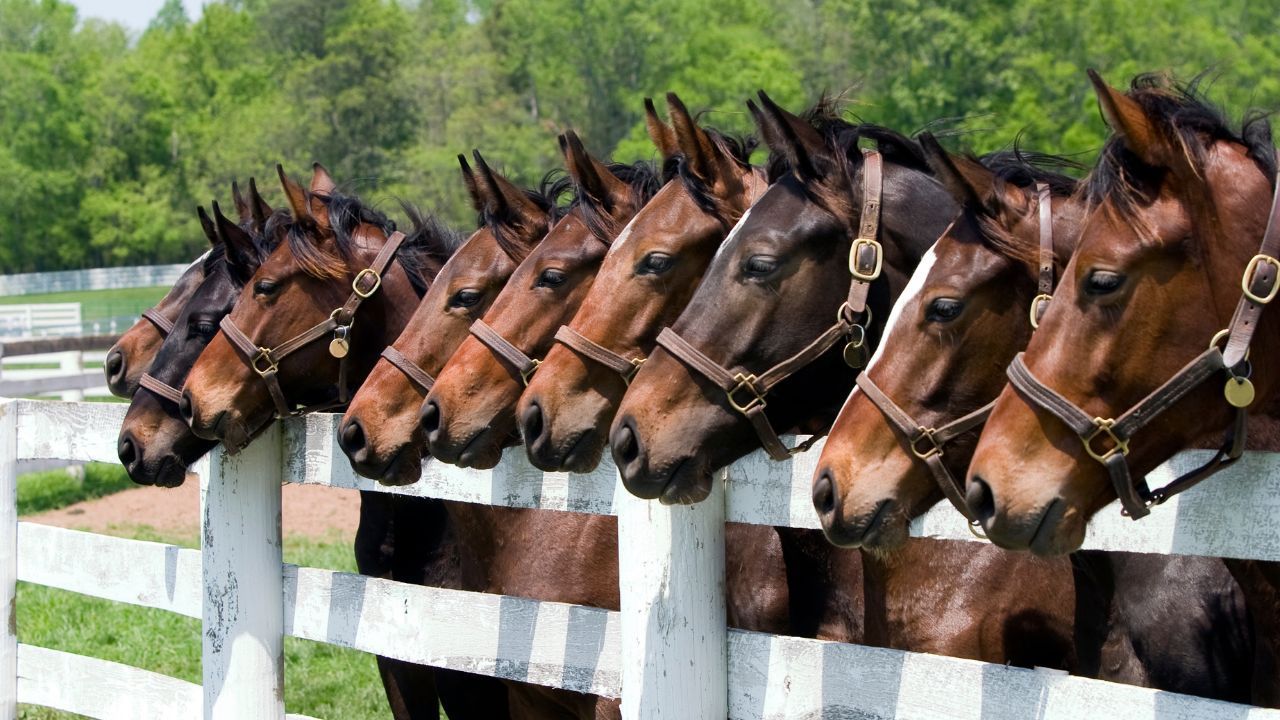Horse Behavior and Psychology: A Complete Guide to Understanding and Managing Equine Stress Factors
Sella Rae, PMP April 2025
Horses possess complex emotional and psychological needs that directly influence their well-being and behavior. Understanding these needs and recognizing signs of stress or anxiety enables horse owners to provide better care and create stronger bonds with their equine companions. Mental health in horses requires careful attention and proactive management strategies.
Horse behavior and psychology form the foundation of successful horse-human relationships. These sensitive animals respond to environmental changes, social dynamics, and human interactions in ways that reflect their innate fight-or-flight instincts.
Equine emotional intelligence plays a crucial role in their daily interactions. Horses can perceive and mirror human emotions, making them exceptional partners in both recreational activities and therapeutic settings.
Key Takeaways
- Recognizing and responding to horse behavior signals strengthens the human-horse bond
- Environmental factors and daily routines significantly impact equine mental well-being
- Consistent training approaches combined with emotional awareness create lasting positive results
Understanding Horse Behavior
Horses exhibit complex behavioral patterns rooted in their evolution as prey animals and social herd dwellers. Their reactions and responses stem from deeply ingrained survival instincts combined with learned experiences.
Fundamentals of Equine Behavior
Horses are prey animals with highly developed fight-or-flight responses. This instinctive behavior shapes how they interact with their environment and handlers.
A horse's response to potential threats involves scanning their surroundings continuously and maintaining awareness of escape routes. They process new situations through this survival lens.
Their natural behaviors include grazing 16-20 hours daily, moving consistently, and seeking safety in numbers. These instincts remain strong even in domesticated horses.
Social Structures and Herd Hierarchy
Wild and domestic horses maintain strict social hierarchies. The lead mare typically controls daily herd movement and activities, while a dominant stallion provides protection.
Mid-ranking horses often act as lookouts and help maintain order. Lower-ranking members benefit from the group's protection while accepting their subordinate position.
Emotional regulation and self-awareness develop through these complex social interactions. New horses introduced to a group must establish their place gradually.
Communication Through Body Language and Vocalizations
Ear position serves as a key indicator of mood: forward ears show interest, pinned ears signal aggression or fear. Tail position similarly conveys emotional state - raised tail indicates excitement or alarm.
Horses use various vocalizations:
- Neighing: Location calls or greetings
- Squealing: Warning or excitement
- Snorting: Alert signals
- Nickering: Gentle greeting or acknowledgment
Non-verbal cues between horses and handlers form the foundation of successful training and relationship building. Reading and responding appropriately to these signals creates trust.
Subtle changes in muscle tension, head position, and stance provide early warning signs of stress or discomfort that handlers must recognize.
Psychological and Emotional Needs
Horses experience complex emotions and require specific mental support to thrive. Their psychological health directly impacts their physical well-being and behavioral patterns.
Emotions and Empathy in Horses
Horses experience a wide range of emotions, including joy, fear, anxiety, and contentment. They demonstrate remarkable sensitivity to human emotional states and can mirror their handler's feelings.
A horse's emotional state manifests through body language, facial expressions, and ear positioning. A relaxed lower lip, soft eyes, and forward-pointing ears indicate contentment.
Negative emotions often appear through elevated head carriage, tail swishing, or pawing at the ground. These signals require immediate attention to prevent stress escalation.
Mental Well-being and Emotional Regulation
Mental stimulation promotes equine well-being. Provide varied activities like ground work exercises, obstacle courses, and social interactions with other horses.
Establish consistent daily routines to create security and reduce anxiety. Regular turnout time allows natural behaviors and mental decompression.
Environmental enrichment tools such as treat balls, scratching posts, and different textures in their living space support cognitive health.
Building Trust and Self-confidence
Strong horse-handler relationships develop through patient, consistent interactions. Begin with simple groundwork exercises and gradually increase complexity.
Use positive reinforcement techniques like praise and treats to reward desired behaviors. This builds confidence and strengthens the bond.
Allow horses to process new experiences at their own pace. Rushing or forcing interactions damages trust and creates lasting anxiety.
Regular handling sessions in different environments help build adaptability and reduce fear responses to new situations.
Equine-Assisted Activities
Horses possess natural therapeutic qualities that make them ideal partners in mental health treatment and emotional healing. Their sensitivity to human emotions and non-verbal cues creates powerful opportunities for personal growth and healing.
Therapeutic Roles of Horses
Equine-assisted psychotherapy pairs clients with horses under professional supervision for activities like grooming, feeding, and leading. These interactions help develop trust, confidence, and emotional awareness.
Horses mirror human emotions and behaviors, providing immediate feedback that helps clients recognize their own patterns. Their large size requires respect and clear communication, teaching boundary-setting and assertiveness.
Working with horses reduces anxiety and stress through rhythmic movement and focused attention. The calm, accepting nature of horses creates a safe space for emotional expression.
Horsemanship and Equine-Assisted Therapy
Learning horsemanship skills promotes positive behavioral changes through emotional engagement and relationship building. Basic care activities teach responsibility while developing empathy and patience.
Grooming sessions allow for quiet reflection and physical connection. Leading exercises build leadership skills and non-verbal communication abilities.
Key therapeutic benefits include:
- Improved self-confidence
- Enhanced emotional regulation
- Better social skills
- Reduced symptoms of anxiety and depression
- Increased mindfulness
- Stronger problem-solving abilities
Regular interaction with horses in structured therapeutic settings helps clients develop lasting emotional resilience and coping strategies.
Effective Communication Skills
Clear communication forms the foundation of a strong horse-human partnership. Horses respond to subtle cues, body language, and emotional energy, making it essential to develop refined communication skills.
Developing Communication with Your Horse
Building a strong bond with your horse requires consistent, clear signals and attentive observation. Use deliberate body positioning and maintain a calm, confident demeanor during interactions.
Creating mental imagery while communicating helps establish clearer intentions. Visualize the desired outcome while maintaining steady breathing and relaxed body language.
Pay attention to your horse's ear position, tail movement, and facial expressions. These indicators provide immediate feedback about their understanding and comfort level.
Keep training sessions brief and positive. Reward small improvements with gentle praise or light touches rather than treats. This reinforces the communication pathway without creating food-motivated behaviors.
Match your energy level to the situation. A quiet, low-energy approach works best for nervous horses, while confident, direct communication helps establish leadership with dominant personalities.
Horses mirror human emotions, so maintaining emotional control is crucial. Take deep breaths and reset your mental state if you feel frustrated or tense during training sessions. Your horse will respond better to calm, purposeful communication.
Training and Behavior Modification
Horse behavior requires patient, consistent training methods based on proven techniques and understanding of equine psychology. The right approach creates lasting positive changes while strengthening the bond between horse and handler.
Implementing Training Techniques
Start training sessions in a quiet, familiar environment to minimize distractions. Keep sessions short - 15-20 minutes maximum - to maintain the horse's focus and prevent mental fatigue.
Use clear, consistent cues and commands. A horse learns best through immediate release of pressure when they perform the desired behavior correctly.
Ground work forms the foundation of good training. Practice leading exercises, backing up, and yielding to pressure before progressing to more advanced work.
Break complex tasks into small, manageable steps. This approach prevents overwhelming the horse and builds confidence through steady success.
Positive Reinforcement and Problem Solving
Effective horse training relies on well-timed rewards and consistent responses to unwanted behaviors. Reward desired responses with praise, gentle patting, or small treats.
Address unwanted behaviors by redirecting the horse's attention rather than punishment. If a horse shows anxiety or resistance, return to simpler exercises they can perform confidently.
Monitor body language closely during training. Pinned ears, tail swishing, or tense muscles indicate stress - adjust your approach accordingly.
Create positive associations with potentially scary objects or situations through systematic desensitization. Allow the horse to investigate new items at their own pace.
Health and Nutrition
Proper nutrition and preventive health care significantly impact a horse's mental state and emotional well-being. Nutritional imbalances and underlying health conditions can manifest as behavioral changes or psychological distress.
Dietary Needs and Nutrition Management
Horse feed ingredients directly influence behavior and emotional stability. High-sugar or high-starch feeds can cause excitability and anxiety.
A balanced diet should include:
- 1.5-2% of body weight in forage daily
- Clean, fresh water available 24/7
- Essential minerals and vitamins
- Limited grain concentrates
Feed testing helps identify nutritional gaps. Split daily feed into 3-4 smaller meals to match natural grazing patterns.
Avoid synthetic additives and preservatives in commercial feeds. These can trigger adverse reactions or hyperactivity.
Recognizing and Addressing Health Issues
Changes in behavior often signal health problems. Common signs include:
- Sudden aggression or withdrawal
- Changes in eating patterns
- Unusual lethargy
- Head pressing or teeth grinding
Regular veterinary checkups prevent small issues from escalating. Dental care affects both nutrition absorption and comfort.
Track vital signs daily:
- Temperature: 99-101°F
- Resting heart rate: 28-44 BPM
- Respiratory rate: 8-16 breaths/minute
Maintain vaccination schedules while monitoring for adverse reactions. Some horses need modified protocols based on individual sensitivity.
Stress Factors and Agitators
Horses face numerous physical and environmental challenges that can trigger stress responses and behavioral changes. Recognizing these triggers enables owners to create safer, more comfortable environments for their equine companions.
Environmental and Dietary Agitators
Environmental changes like extreme temperatures, sudden weather shifts, and poor shelter conditions can significantly impact a horse's well-being. Excessive heat, cold, or humidity often leads to physical discomfort and anxiety.
Water quality plays a crucial role in horse health. Contaminated water sources or sudden changes in water taste can cause dehydration as horses may refuse to drink unfamiliar water.
Chemical exposure through pesticides, fertilizers, and agricultural sprays near pastures can trigger respiratory issues and skin sensitivities. Creating buffer zones between treated areas and grazing spaces helps minimize exposure.
Food additives and sudden diet changes can cause digestive upset and stress. Maintain consistent feeding schedules and gradually introduce new feeds over 7-10 days.
Social and Physical Stressors
Changes in social dynamics like introducing new horses or removing herd members can trigger anxiety and defensive behaviors. Allow proper introduction periods in adjacent spaces before direct contact.
Transportation and road trips often create significant stress. Proper trailer training, regular breaks, and familiar companions can help reduce travel anxiety.
Loud or unexpected noises from machinery, traffic, or construction can startle horses and create lasting tension. Gradual desensitization to common sounds helps build confidence.
New handlers or frequent changes in human interaction can disrupt established trust patterns. Maintain consistent handling protocols and introduce new people gradually under controlled circumstances.
Strategies for Minimizing Stress
Implementing effective stress reduction techniques creates calmer, healthier horses through environmental modifications and proper daily care routines. A proactive approach helps prevent anxiety-related behaviors before they develop.
Overcoming Negative Environmental Factors
Playing relaxing music for stabled horses significantly improves their emotional state. Aim for 3 hours of classical or instrumental music daily during rest periods.
Natural lighting and proper ventilation are crucial stress reducers. Install windows or clear panels to allow sunlight while maintaining temperature control.
Create safe, enriched environments with multiple feeding stations and toys like treat balls or scratching posts to prevent boredom.
Buffer loud noises by installing sound-dampening materials in barn walls. Place stables away from machinery, traffic, and other disruptive sounds.
Management Techniques for Optimal Care
Establish consistent daily routines for feeding, turnout, and exercise. Horses thrive on predictability and structure.
Gentle leadership techniques using clear body language and cues help build trust while reducing anxiety during training sessions.
Introduce new experiences gradually. Whether it's new people, horses, or environments, allow time for proper acclimation.
Monitor signs of stress and anxiety like tail swishing, pawing, or excessive sweating. Address triggers promptly through environmental changes or routine adjustments.
Regular exercise and social interaction with compatible herd mates promotes mental well-being and reduces stress-related behaviors.
Building Stronger Bonds
Horses have an innate ability to connect emotionally with both humans and other horses through deep, meaningful relationships built on mutual trust and understanding.
Creating a Positive Human-Horse Relationship
Start by spending quiet time near your horse without demanding anything. Simply being present while they eat or rest helps establish comfort and familiarity.
Use gentle, consistent body language and maintain a calm demeanor. Horses respond well to soft touches, steady breathing, and measured movements.
Ground exercises build trust effectively. Lead your horse through basic tasks like walking, stopping, and turning while rewarding good behavior with praise and gentle strokes.
Developing a meaningful bond provides unique psychological rewards for both horse and human. Regular grooming sessions offer excellent opportunities for physical connection and emotional bonding.
Reinforcing Social Relationships Among Horses
Horses thrive in complex social structures and need regular interaction with other equines. Provide opportunities for supervised socialization in safe, controlled environments.
Consider compatible personality matches when grouping horses. Some horses prefer one or two close companions while others enjoy larger herds.
Maintain consistent groupings when possible. Frequent changes in herd composition can create stress and disrupt established relationships.
Allow sufficient space for natural behaviors like mutual grooming and play. These activities strengthen bonds between horses and support their emotional wellbeing.
Involvement in the Equestrian Community
Mental health support in equestrian circles plays a vital role in both horse and human wellbeing. Regular participation in local horse activities creates a strong support network for managing equine care challenges.
Join riding clubs, attend clinics, and participate in workshops to learn from experienced horse owners. These connections provide valuable insights into horse behavior and management techniques.
Equestrian trainers contribute significantly to developing proper horsemanship skills. They teach essential techniques while building rider confidence and promoting safe interactions with horses.
Social media groups and online forums offer platforms to discuss horse care, share experiences, and seek advice. Many communities organize events focused on natural horsemanship and holistic horse care approaches.
Volunteering at therapeutic riding centers helps develop deeper understanding of horse-human relationships. These experiences enhance social skills while contributing to the broader equestrian community.
Key Community Activities:
- Local horse shows and competitions
- Educational seminars
- Barn social events
- Group trail rides
- Tack swap meets
- Youth mentoring programs
Regular community involvement strengthens horse handling abilities and builds lasting friendships with fellow enthusiasts. These connections provide emotional support during challenging situations with horses.
Frequently Asked Questions
Horses communicate their needs, fears, and comfort levels through distinct behavioral patterns that owners can learn to interpret and address. Proper understanding of these signals enables more effective care and management strategies tailored to each horse's individual requirements.
How can recognizing and addressing horse behavior improve their care?
Understanding equine psychology helps identify stress, anxiety, and contentment through body language and behavioral cues.
Reading ear position, tail movement, and facial expressions allows quick responses to potential issues before they escalate.
Regular observation of eating, drinking, and social habits creates baseline knowledge to spot concerning changes early.
What practical strategies can horse owners implement to better meet their horses' psychological needs?
Maintaining consistent daily routines reduces anxiety and builds trust between horses and caretakers.
Horses experience complex emotions that require mental stimulation through enrichment activities like obstacle courses and food puzzles.
Providing opportunities for natural behaviors like grazing and socializing with other horses supports psychological wellbeing.
Which weather conditions have significant impacts on horse behavior, and how can they be mitigated?
Strong winds and storms can trigger flight responses and anxiety, requiring secure shelter options.
Extreme heat may cause lethargy and reduced appetite, necessitating adjusted feeding schedules and cooling measures.
Cold snaps increase energy requirements and may amplify herd dynamics as horses seek warmth together.
In what ways can diet and medication influence horse behavior, and what best practices should be followed?
High-sugar feeds can cause hyperactivity and mood swings, while proper forage-based diets promote calmer behavior.
Some medications may cause drowsiness or increased energy levels, requiring careful monitoring and dosage adjustments.
Feed changes should occur gradually over 7-10 days to prevent digestive upset and associated behavioral changes.
How do interactions with other animals, unfamiliar humans or new environments affect horse psychology?
New situations can trigger stress responses that manifest as pawing, sweating, or refusing to move forward.
Introducing horses to new herd members requires careful supervision and adequate space for establishing hierarchy.
Unfamiliar handlers should approach calmly and allow horses time to investigate them through smell and sight.
What are effective methods to minimize stress for horses during travel and exposure to noise?
Training horses to load calmly through positive reinforcement reduces transport anxiety.
Providing hay during travel keeps horses occupied and maintains normal digestive function.
Using familiar equipment and maintaining direct contact with trusted handlers helps horses cope with unsettling situations.



